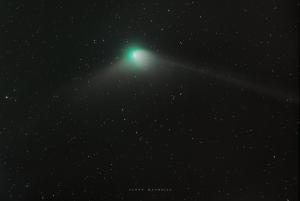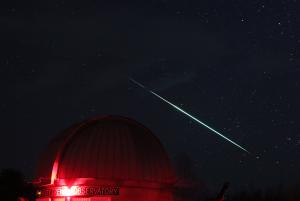Celebration of Space - November 10, 2023

Neptune and it's rather teal coloring. Credit: Scott MacNeill captured this image at Brown University's Ladd Observatory.
This coming Monday, November 13, 2023, Earth will reach the point in our orbit around the Sun, where Uranus aligns on the opposite side of Earth than the Sun. We call this the “Opposition of Uranus”, and places Uranus into the best telescope viewing. On the night of opposition Uranus will be 1.732 billion miles distant from Earth, which will delay our view by about 2 hours and 40 minutes. In the Frosty Drew telescope, Uranus appears as a small blue planet with up-to five very faint moons in view (Titania, Oberon, Ariel, Umbriel, and Miranda). On the day of opposition, Uranus will rise with the setting Sun, and set with the rising Sun, being above the horizon for the entire nighttime period. Once opposition passes, Uranus will be above the horizon after sunset, rising a little higher in the sky each passing night. The weeks around opposition are the best time to catch a view, so make plans to visit Frosty Drew for a view of Uranus.
Over the past several months a new comet has made its way into the inner Solar System. The comet is designated C/2023 H2 (Lemmon), and it is a long period comet with an orbital period of 3,872 years. Comet Lemmon made its closest approach to the Sun, called perihelion, on October 29, 2023, and will make its closest approach to Earth tomorrow, Saturday, November 11, 2023, at a distance of 17,941,942 miles away. This places Comet Lemmon into the best viewing right now. Recent observations have shown the comet has brightened to binocular visibility, and is currently high enough in the evening sky to be seen after twilight wanes. Tonight, the comet is passing through the constellation Hercules, and will be moving into the constellation Aquila tomorrow night (Saturday). Since the new Moon occurs on Monday morning, we will have excellent viewing opportunities to see the comet this weekend and coming week. Here is a finder chart to help with finding the comet over the next few nights. You will need to be at a spot with little to no light pollution, and be there no later than 7:00 pm. Best views will be in a small backyard telescope, but a binocular view should reveal the comet’s bright coma, which is an atmosphere that forms around the comet’s nucleus. Let us know if you see the comet.
Overnight Saturday-Sunday, November 11-12, 2023, the Northern Taurid Meteor Shower will peak, bringing with it an increase in regular meteor activity by about 5 meteors per hour. Like the Southern Taurid shower, the Northern Taurids also bring an increase in fireball meteors, which are meteors that are brighter and longer lasting than your regular shooting star. Even though the peak nights are not crazy active like the Geminid shower, the prospect of seeing fireball meteors is too good to overlook. So set out tomorrow night around 10:00 pm to a spot with a dark, wide open view of the night sky, and be there before midnight. Lay on your back with your feet oriented towards the southeast and look to the zenith (top of the sky) to catch meteors zooming by. Note that this is a slow moving meteor shower, so there will be long periods in between visible meteors. Let us know if you spot any Taurid meteors.
This coming Monday, November 13, 2023, the International Space Station (ISS) will return to the evening sky over the United States, commencing visible passes during the early evening hours. Even though visible passes start on Monday, notable passes will not kick in until Wednesday, November 15th. During the months around the Winter Solstice, we see a much smaller window of opportunity to spot satellites passing overhead in the Northern Hemisphere. This is due to our region being tilted away from the Sun. For a satellite to be visible as it passes over it has to be in direct sunlight while the ground-based observer is in darkness. During our winter, we are oriented further into Earth’s shadow at night, keeping satellites that pass over out of direct sunlight. The best time to observe satellite passes are during the evening and early morning hours during the colder time of the year. Here is the only notable pass of the ISS for the coming week:
Wed, Nov 15 at 6:21 pm, starting in the SW, rising to 35°, and into orbital sunset
Next weekend and the following week will bring significantly better views of the ISS passing over our region. Take a moment to read upon why the ISS is only visible during certain times of the night and year. Then set your alarm for the only good pass this week, and keep in mind that excellent passes are just a week away. For daily pass times of the ISS and other bright satellites, visit the Frosty Drew Daily Satellite Pass Prediction Utility.
- Author:
- Scott MacNeill
- Entry Date:
- Nov 10, 2023
- Published Under:
- Scott MacNeill's Columns




